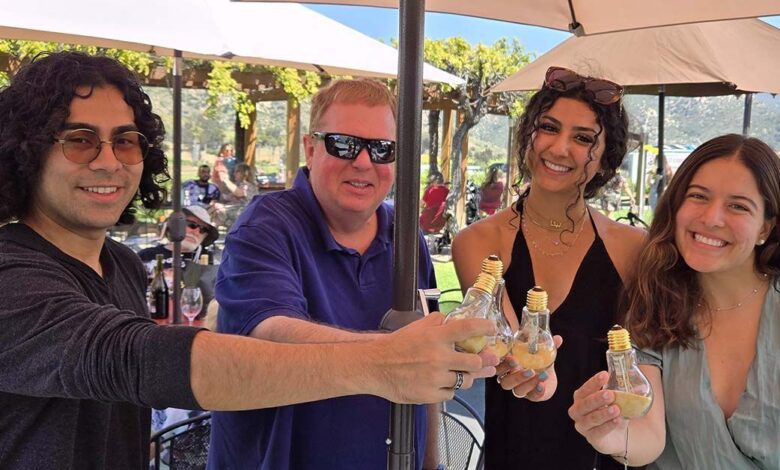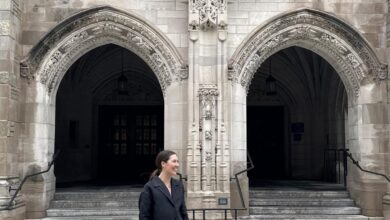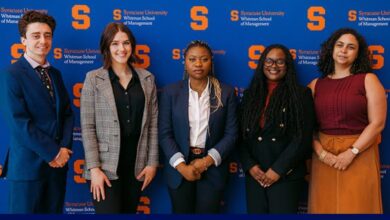UC San Diego Team Wins Entrepreneurship Challenge for Third Year in a Row

Article Content
When paramedics arrive at the scene, they confront a woman experiencing classic signs of a stroke. She is confused, slurring her words and having difficulty moving one arm. The first responders know that time is of the essence. For every minute that a stroke patient goes untreated, the more brain cells die and the worse the patient’s prognosis.
But treatment depends on what type of stroke it is—whether it is caused by a blockage of vessels or bleeding inside the brain. Administering the wrong treatment makes the patient’s condition worse. So there is little the paramedics can do except transport the patient to the hospital to be examined by medical staff there.
A team of students from the University of California San Diego hopes to rewrite the ending to stories like this one, which represent an all-too-common scenario; stroke is the second-leading cause of death worldwide, according to the World Health Organization. The UC San Diego team wants to create a company to give first responders and emergency room personnel a new, portable and cost-effective tool to rapidly diagnose stroke patients and speed treatment.
The team’s pitch was awarded first place in the National Nanotechnology Entrepreneurship Challenge (NTEC), which also drew competitors from Stanford University, Virginia Tech and others of the National Nanotechnology Coordinated Infrastructure network. This is the third year in a row that a team from UC San Diego mentored by Yves Theriault, program manager for education and outreach at the UC San Diego Qualcomm Institute (QI), has won the competition.
This year’s group is composed of Freddy Garcia, a nanoengineering Ph.D. student in the UC San Diego Jacobs School of Engineering; Beeta Zamani ’24, an undergraduate nanoengineering major in the Jacobs School; and Laura Charria ’24, an undergraduate cognitive science major in the UC San Diego School of Social Sciences.
“It is a great team,” said Theriault, who was joined as a mentor this year by Oscar Vazquez Mena, who is Garcia’s Ph.D. advisor and an associate professor in the Aiiso Yufeng Li Family Department of Chemical and Nano Engineering at the UC San Diego Jacobs School of Engineering. “It’s a winning technology.”
‘Novel Advantages’
The group’s proposal grew out of Garcia’s interest in metamaterials — materials engineered to have properties rarely observed in nature. Garcia realized that metamaterials could be used in conjunction with existing ultrasound technology to surmount current barriers to imaging the brain.
“The novelty of it all comes down to the metamaterials that we’re creating,” said Garcia. “Ultrasound waves propagate through skin — there’s no problem there — but when it comes to a bone like the skull, waves can’t get through. You just get a lot of diffraction. But with the metamaterials between the skull and the ultrasound waves, you can allow waves to go through by matching the impedance of the skull.”
As part of the NTEC program, the students sought out and interviewed potential customers to explore the market for products that could be created from this technology.
After completing 21 interviews, the students chose to focus on imaging for rapid diagnosis of strokes. While the competition in this space included portable CT scanners, these machines were expensive, bulky and energy- and staff-intensive compared to the ultrasound device the students wanted to offer.
“We can essentially have a headgear that you put on [a patient],” Zamani said. “You’re able to leave that on and have imaging of the brain and extended blood flow monitoring, which are really novel advantages. Making that portable and accessible is really the niche that we’re trying to target.”
The Winning Formula
The NTEC competition culminated in a virtual showcase event in which each team presented a two-minute video about its work to a panel of judges.
“The competition was intense, very tough,” said Garcia. “And there was more competition than last year, because there were 15 groups instead of 10.”
Ultimately, though, the UC San Diego team prevailed.
Garcia credits his teammates. “Beeta and Laura really transformed this idea we had into something that was easy to digest and fun to look at with the presentation,” he said. “Everyone had great technology; it was interesting, cutting-edge. But, in the end, if you can’t really translate that to two minutes, you lose a lot of people. So the creativity, ideas, technology, innovation, and putting that all together into a two-minute video set us apart. I’m really proud to have these people on my team.”
“Being able to work with your team — especially when it’s getting down to the deadlines — and to effectively communicate to your audience, your investors and your end-users is really so fundamental,” added Zamani.
Charria not only praised her teammates, but also called out the group’s origins in the Qualcomm Institute’s cleanroom facility, Nano3. “I feel it’s important to trace our group back to Nano3 and the Qualcomm Institute,” she said. “Without them, I wouldn’t have been able to meet everyone on the team, including Freddy, Beeta and Yves.”
Bringing It Forward
While the team is at somewhat of a crossroads—Charria and Zamani are graduating as Garcia continues his Ph.D. studies—the startup continues to evolve.
Garcia notes that, in addition to the NTEC program, the business idea is being honed through two other entrepreneurship programs: the National Science Foundation’s Innovation Corps (I-Corps), which they just finished, and the MedTech Acceleration Program in the UC San Diego Institute for the Global Entrepreneur.
“The MedTech accelerator covers the foundations for entrepreneurs and what we have to look into,” said Garcia. “They go very deep into it, including FDA regulations, so that’s been helping a lot.”
In the meantime, as they look toward graduation, Charria and Zamani appreciate how much they learned from the NTEC competition.
“[NTEC] is an opportunity that I wish every student had the opportunity to experience at least once in their life,” said Charria. “It’s not only about working on our own startup, but also listening and learning from what the other teams are doing all around the nation.”
“A lot of the engineering curriculum is focused on teaching you the theories, how to be an engineer, all the technical details,” said Zamani. “Being more involved in the entrepreneurship aspects allowed me to see how technical knowledge can be used in conjunction with business strategies to make powerful technologies that can really change the world.”
Learn more about the UC San Diego Qualcomm Institute’s nanotechnology facilities and internships.



